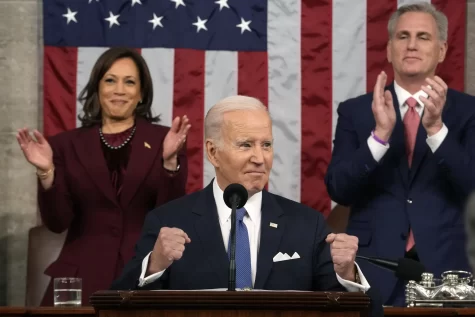Student Enrollment Surpasses 19,000
A growing campus comes with higher expenses, but at some point it may also infringe on the higher education experience.
History was made when the largest Oakland University undergraduate class entered classrooms on and off campus this fall.
Since its humble beginnings in 1959, when a complete fall headcount reported 570 OU students, the university has grown to accommodate an all-time high of 19,053 students this year.
“As a person who is responsible, I was pleased to see overall that we are up,” said Mary Beth Snyder, vice president for Student Affairs and Enrollment Management. “It’s a modest increase, but it shows the strength of Oakland in attracting very good students.”
Each year, the Office of Institutional Research and Assessment or OIRA collects information about the demographics of the school. This year’s headcount was completed Sept. 23.
“Any growth is a good rate because if we’re not growing, we’re dying” Mick Ide, a groundskeeper and 1999 grad, said. “I am very pleased to see the university growing as such a rate.”
Counting it out
In addition to the record-breaking enrollment numbers that increased 1.7 percent from last year, there was an 8.8 percent rise in transfer students.
The Office of the Registrar has a specific team whose goal is to assist transfer students with a smoother transition into OU and offers programs like the upcoming transfer open house scheduled for Oct. 28.
“I think the economy is a factor in the growth we’ve seen in transfers,” Snyder said. “What I believe is happening is that families are deciding that they can afford a community college for two years … they’re economizing.”
She said that transfer requirements have been articulated to area feeder schools like Macomb and Oakland Community Colleges “quite well” and thinks OU “will see increased numbers of transfer students over the next few years.”
The transfer team won an award this year from the Michigan Association of Collegiate Registrars and Admissions Officers.
More students, presence
Including the economic trends noted for the increase in transfer students, Snyder also believes that a higher number of scholarship students is a reason enrollment numbers are going up. She said this adds to a “healthy academic reputation.”
“It’s about quality academic programs that have gained some stature and an unbelievably talented faculty,” OU director of media relations Ted Montgomery said.
Three years ago, the scholarship policy was changed so that scholarships could be guaranteed for four years as long as the student met academic eligibility. OU’s offer is unlike many other colleges, Snyder said.
Chemistry professor Joel Russell has been teaching at OU for many years and has seen a steady increase in class sizes, but said that classes have not yet reached full capacity.
Jim Zentmeyer, director of University Housing, said the increased numbers bode well “to the concept that something very special is going on at OU.
“The OU student is coming to campus stronger, better prepared and in a position to seek the most out of their education,” Zentmeyer said. “That will have a solid impact on retention numbers so that a student that comes to OU is able to succeed at OU.”
There is no indication thus far of a rise in retention rates or graduation rates over the span of enrollment growth, according to data presented by the OIRA.
Though admissions standards are not rising, Zentmeyer and Snyder said that the quality of incoming students is going up. That is true, as the OIRA reports that this year’s incoming class had an average high school grade point average of 3.3 and the average ACT score was 22.4, up from last year’s average of 22.
“The university’s strategic goal is to grow, but it’s equally important that we grow in a way that increases the academic profile,” said Eleanor Reynolds, assistant vice president for Student Affairs and director of undergraduate admissions.
Russell said he feels students are coming in as prepared because more students are being admitted and that the amounts in which average scores are going up in so small that it is “not detectable.”
In 1982, the school adopted a ‘vision statement’ to better spell out its role in Michigan higher education. One of the components is the “2020 Vision,” which lists the goals the university wants to achieve by the year 2020.
An aspect of the plan that has come under some scrutiny is the hope that “future growth and enrollment will continue toward a 25,000 student target, with growth also in faculty, staff, campus and student services, and technology enhancements.”
As OU student congress student services director, Brett McIsaac must create projects and present solutions to concerns raised by students. He hopes that more students on campus will mean that more of the initiatives proposed by the Congress will be implemented.
“We will adjust our services accordingly as (larger) numbers come,” McIsaac, a junior biomedical engineering major, said. “There is no need to adjust now and we will just have to expand if we want more students.”
To McIsaac, the university’s 2020 goal will put OU above its “competition,” which he said seems to be Grand Valley State University in terms of admissions requirements and size.
Reynolds said the school now has a more well-known presence in surrounding communities and around the state.
“It’s fun to go into communities and find out they know who and where we are,” Reynolds said. “We’re targeting students in a strategic way.”
Reynolds and McIsaac believe that OU will become a destination that will begin to contend with traditional in-state, first-choice schools.
“Growth is good for the university because it makes us a lot more comparable to U of M and State,” McIsaac said.
The number of campus tours given on weekdays has doubled and Reynolds said Saturdays tours are also filled now with prospective students and their families.
Snyder said that while she can’t promise it will be true, she thinks 25,000 students is “an attainable goal” and that “in time, Oakland will be that size.”
“With the economy and changing demographics, we’ll probably not meet that in the next five years,” she said.
Brandon Hanna, a sophomore majoring in biology, serves as the Student Activities Funding Board Chair. The SAFB divides student activities money between over 200 student organizations.
“There has definitely been an increase already in the number of student organizations,” said Hanna, who took on the job at the end of August.
According to Russell, the university will probably hire more part-time faculty to meet the higher demand as more students come in.
“Having a lot of part-time faculty shortchanges the student,” said Russell, who explained that because most part-time faculty will work at multiple institutions and therefore not be focused on OU, the “quality of faculty will go down for students.”
He also said the ability to have a say in academic governance would be hindered as more part-time faculty members are hired.
Pressure on Housing
Jacqui Stephens, a junior majoring in communication, has lived on campus since she began taking classes, and believes OU is growing too quickly.
Stephens is one of many students who applied for a single room and did not get assigned one due to an increase in housing contracts and believes OU should “get more dorm rooms” and “expand to meet demand.”
She said that she enjoys partaking in the “campus experience” and the convenience of not having to commute, but does not get along well with others in close quarters. Stephens believes her chances of ever securing a single room now are even smaller due to increased enrollment.
“If they expanded more, they would have more singles,” Stephens said. “How are enrollment increases making things better on this small campus?”
Zentmeyer admitted that the increase “has definitely put some limitations on us as far as flexibility.”
Along with the thirteenth straight year of enrollment increases, the squeeze on limited campus housing has also been tightened as the number of housing contracts begins to near the maximum number of beds on campus.
“There was a 9 to 10 percent increase in housing contracts from last year,” Zentmeyer said, noting that enrollment grew by 1.7 percent over the same period. “We are seeing a greater growth in housing that’s outpacing enrollment.”
Turning single rooms into doubles maximized campus housing and rooms that could accommodate three were used to do so, much to the ire of students like Stephens.
Zentmeyer said that housing alternatives were considered and accounted for this year, though every student who applied ended up receiving an on-campus housing assignment.
Snyder said OU has “definitely planned to expand housing to meet the demand.” Last summer, a master plan was presented to the board of trustees for a new housing complex that would create apartment-style living for about 400 students.
The project has not gone back to the board for approval yet, but Snyder is hoping it will be done “some time within the next year.”
Zentmeyer said any additional building would take cooperation from “the entire university” because the housing department is self-supporting and does not receive money from general funds.
“It would be housing’s responsibility to fund that debt,” Zentmeyer said.
The proposal was tabled last November due to that very issue, since the construction would cost around $28 million.
“We won’t ever become a big residential campus, but I do foresee the day where we have about 4,000 out of 25,000 living on campus,” Snyder said. “That is still critical math for student involvement and school spirit.”
A parking problem
Parking is another constant student concern as more students come to campus.
“Parking is going to be even more screwed,” said Emily Cutlip, a junior English major. “OU is a great place to go, but that was the first thing I thought of when enrollment went up.”
As a commuter, Hanna said he makes sure he arrives on campus early to avoid fighting for parking.
However, he said he does understand the discontentment voiced by those who attend afternoon classes because it is the busiest time.
“Physical facilities must go along with the growth,” professor Russell said. “We might not be able to adequately serve students without additional money since more students mean more expenses.”
Ide said he sees plenty of spaces available on any given day and said that turf parking prepared by Grounds and Maintenance before the beginning of the 2010-11 school year was never utilized.
McIsaac, who spearheaded the creation of the Bear Bus parking shuttle, said there is no parking issue according to data collected by the OU Police Department.
“There hasn’t been a time when all parking was at full capacity, and that’s just counting spots in concrete parking lots,” McIsaac said.
He said the program is currently being expanded.
Covering new ground
Ide’s largest concern is the ability of grounds and maintenance workers to keep up with the physical growth of the campus as new buildings and parking lots are added.
“It is getting harder and harder to cover all areas with existing personnel as we’re adding buildings and parking lots,” said Ide, who is the vice president of the Campus Maintenance and Trade union.
He said that work is still getting done, however, even with it being “tougher to get everything cleaned off in time for students, faculty and staff to arrive.”
Though many cringe at the thought of having to compete with more students for seemingly scarce resources like parking or housing, administrators and students are seeing it as a positive thing for campus life.
“Students are becoming much more involved,” Zentmeyer said of students living on campus. “It’s more of a desired location now.”
“We will need to spend more money on organizations, but membership will hopefully be increased too,” Hanna said. “It works both ways and I do think that increased enrollment means increased involvement.”
Snyder said she believes as more people live on a campus, the more active campus life becomes.
“Even if you commute, OU is like being at a university in almost every aspect,” Cutlip said. “I definitely think this could bring more to campus activities.”











